In 1446, Manaa’ Al-Muraide, leader of the Marada clan of the Al-Duru tribe of the Banu Hanifah, led his people inland from their home near Qatif on the Gulf Coast at the invitation of his cousin, Ibn Dir, the ruler of Hajr — modern-day Riyadh.
Wadi Hanifah, where they settled and where the city of Diriyah would later rise, was named after the Banu Hanifah.
However, its fall in 1818 led to the modern Kingdom as we know it today amid the re-establishment of the state with a new capital, known as Riyadh. Sifting between dynasties and wars, 1932 oversaw the complete reign of King Abdulaziz, who established the Kingdom of Saudi Arabia in its entirety.
The significance of the year 1727 in the story of Saudi Arabia has become ever more apparent in the light of extensive research carried out by historians and archaeologists.
In 2010, such work led to the At-Turaif district of Diriyah, the birthplace of the nation, being inscribed on UNESCO’s World Heritage List as a site of “outstanding universal value.”
Founding Day is not intended to replace Saudi National Day (September 23rd), which celebrates the unification of the Kingdom of Saudi Arabia in 1932, but rather to recognize the beginning of the Saudi state’s history with a new event that celebrates the deep historical roots of the Kingdom.
